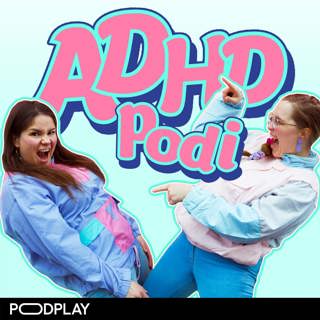
Episode 50 - Mental Health
We're celebrating 50 episodes of ABA Inside Track by going where BCBAs are wary to tread: mental health! We discuss why ABA and mental health stopped getting along and discuss ideas as to how behavior analysis can make a difference in treating mental illness. Then we save a nice chunk of time for Rob to go full hippy in his tear down of Big Pharma. But, can any of this content help Diana get over her mall-o-phobia? Articles discussed this episode: Harvey, M.T., Luiselli, J.K., & Wong, S.E. (2009). Application of applied behavior analysis to mental health issues. Psychological Services, 6, 212-222. doi: 10.1037/a0016495 Wong, S.E. (2006). Behavior analysis of psychotic disorders: Scientific dead end or casualty of the mental health political economy? Behavior and Social Issues, 15, 152-177. doi: 10.5210/bsi.v15i2.365 Singh, N.N., Matson, J.L., Lancioni, G.F., Singh, A.N., Adkins, A.D., McKeegan, G.F., & Brown, S.W. (2006). Questions about behavioral function in mental illness (QABF-MI): A behavior checklist for functional assessment of maladaptive behavior exhibited by individuals with mental illness. Behavior Modification, 30, 739-751. doi: 10.1177/0145445506286700 If you're interested in ordering CEs for listening to this episode, click here to go to the store page. You'll need to enter your name, BCBA #, and the two episode secret code words to complete the purchase. Email us at abainsidetrack@gmail.com for further assistance.
28 Helmi 20181h 21min

Episode 50 Preview
Next week we're doing an historical dive into the past of behavior analysis to discuss just why it is that ABA isn't "cool" when treating mental illness and to figure out just what ABA has to offer the field of mental health. But first, it's Wilford vs. Willard, BCBAs vs. outdated New York laws, and Rob's ranting vs. Rob's raving in a no-holds barred edition of Errata. Articles for next week: Harvey, M.T., Luiselli, J.K., & Wong, S.E. (2009). Application of applied behavior analysis to mental health issues. Psychological Services, 6, 212-222. doi: 10.1037/a0016495 Wong, S.E. (2006). Behavior analysis of psychotic disorders: Scientific dead end or casualty of the mental health political economy? Behavior and Social Issues, 15, 152-177. doi: 10.5210/bsi.v15i2.365 Singh, N.N., Matson, J.L., Lancioni, G.F., Singh, A.N., Adkins, A.D., McKeegan, G.F., & Brown, S.W. (2006). Questions about behavioral function in mental illness (QABF-MI): A behavior checklist for functional assessment of maladaptive behavior exhibited by individuals with mental illness. Behavior Modification, 30, 739-751. doi: 10.1177/0145445506286700
21 Helmi 201814min

Episode 49 - Matrix Training w/ Cormac MacManus
Take a deep dive into the Matrix...Training research world with special guest Cormac MacManus. Find out everything you needed to know about this efficient and powerful teaching tool but were afraid to ask. In addition to learning the inside scoop about Cormac's matrix training/video modelling mash-up research, we'll explore the origin story of Irish Batman, Jackie's slow descent into podcasting madness, and Rob's brief brush with stardom. Articles discussed this episode: Axe, J.B. & Sainato, D.M. (2010). Matrix training of preliteracy skills with preschoolers with autism. Journal of Applied Behavior Analysis, 43, 635-652. doi: 10.1901/jaba.2010.43-635 MacManus, C., MacDonald, R., & Ahearn, W.H. (2015). Teaching and generalizing pretend play in children with autism using video modeling and matrix training. Behavioral Interventions, 30, 191-218. doi: 10.1002/bin.1406 If you're interested in ordering CEs for listening to this episode, click here to go to the store page. You'll need to enter your name, BCBA #, and the two episode secret code words to complete the purchase. Email us at abainsidetrack@gmail.com for further assistance.
14 Helmi 20181h 16min

Episode 49 Preview
::RING RING:: Hello, we know you're out there. We can feel you now. We know that you're afraid. You're afraid of efficient teaching methodology. I don't know the future. I didn't come here to tell you how to train individual exemplars. I came here to tell you about matrix training. I'm going to hang up this phone, and then I'm going to podcast to BCBAs what you don't want them to hear. I'm going to tell them about a world of recombinative generalization, a world taught along the diagonal, a world where anything is possible. Where we go from there is a choice I leave to you. ::CUE RAGE AGAINST THE MACHINE:: Articles for next week: Axe, J.B. & Sainato, D.M. (2010). Matrix training of preliteracy skills with preschoolers with autism. Journal of Applied Behavior Analysis, 43, 635-652. doi: 10.1901/jaba.2010.43-635 MacManus, C., MacDonald, R., & Ahearn, W.H. (2015). Teaching and generalizing pretend play in children with autism using video modeling and matrix training. Behavioral Interventions, 30, 191-218. doi: 10.1002/bin.1406
7 Helmi 201816min

Episode 48 - Grab Bag IV: Bride of Grab Bag
Then, from beyond the realms of known behavior analysis comes the research grab bag. This lumbering beast has returned yet again to bring forth research from all corners of the globe. Gaze upon the grab bag's works, ye mighty, and despair that you have yet to learn of disguised mands, portion control, and text-message cueing. But you will, good listener...you will! Articles discussed this episode: Hausman, N.L., Borrero, J.C., Fisher, A., & Kahng, S. (2014). Improving accuracy of portion-size estimations through a stimulus equivalence paradigm. Journal of Applied Behavior Analysis, 47, 485-499. doi: 10.1002/jaba.139 Grosberg, D. & Charlop, M.H. (2017). Teaching conversational speech to children with autism spectrum disorder using text-message prompting. Journal of Applied Behavior Analysis, 50, 789-804. doi: 10.1002/jaba.403 Najdowski, A.C., Bergstrom, R., Tarbox, J., & St. Clair M. (2017). Teaching children with autism to respond to disguised mands. Journal of Applied Behavior Analysis, 50, 733-743. doi: 10.1002/jaba.413 If you're interested in ordering CEs for listening to this episode, click here to go to the store page. You'll need to enter your name, BCBA #, and the two episode secret code words to complete the purchase. Email us at abainsidetrack@gmail.com for further assistance.
31 Tammi 20181h 21min

Episode 48 Preview
Next week's episode is a magical multiple of 12 which means we'll be diving straight into the grab bag! What articles have piqued our fancies this week? Fortunately, Jackie and Diana decide to hijack the podcast with the amazing origin stories of their articles. Rob begrudgingly goes along for the ride. Afterwards: erRATta from listeners! Articles for next week: Hausman, N.L., Borrero, J.C., Fisher, A., & Kahng, S. (2014). Improving accuracy of portion-size estimations through a stimulus equivalence paradigm. Journal of Applied Behavior Analysis, 47, 485-499. doi: 10.1002/jaba.139 Grosberg, D. & Charlop, M.H. (2017). Teaching conversational speech to children with autism spectrum disorder using text-message prompting. Journal of Applied Behavior Analysis, 50, 789-804. doi: 10.1002/jaba.403 Najdowski, A.C., Bergstrom, R., Tarbox, J., & St. Clair M. (2017). Teaching children with autism to respond to disguised mands. Journal of Applied Behavior Analysis, 50, 733-743. doi: 10.1002/jaba.413
24 Tammi 201816min

Episode 47 - Social Reinforcer Assessment
By reading and discussing these two articles, we're pretty confident that every important aspect of social reinforcer assessment gets covered. From back pats to nose beeps, from finding social reinforcers to assessing them. Seriously. It's all here in these two articles. And when you gaze into social reinforcer assessments, social reinforcer assessments gaze into you! Articles discussed this episode: Smaby, K., MacDonald, R.P.F., Ahearn, W.H., & Dube, W.V. (2007) Assessment protocol for identifying preferred social consequences. Behavioral Interventions, 22, 311-318. doi: 10.1002/bin.242 Kelly, M.A., Roscoe, E.M., Hanley, G.P., & Schlichenmeyer, K. (2014). Evaluation of assessment methods for identifying social reinforcers. Journal of Applied Behavior Analysis, 47, 113-135. doi: 10.1002/jaba.107 If you're interested in ordering CEs for listening to this episode, click here to go to the store page. You'll need to enter your name, BCBA #, and the two episode secret code words to complete the purchase. Email us at abainsidetrack@gmail.com for further assistance.
17 Tammi 20181h 14min

Episode 47 Preview
Our newest topic, social reinforcer assessments, gives us such joy, we're seeing fireworks! But, before we get to talking about the big issue, we share some ABA-entertainment for these cold, snowy days, though mostly end up talking about home invasion movies and Hallmark romances. Plus, recent erRATta from the Facebook page. Articles for next week: Smaby, K., MacDonald, R.P.F., Ahearn, W.H., & Dube, W.V. (2007) Assessment protocol for identifying preferred social consequences. Behavioral Interventions, 22, 311-318. doi: 10.1002/bin.242 Kelly, M.A., Roscoe, E.M., Hanley, G.P., & Schlichenmeyer, K. (2014). Evaluation of assessment methods for identifying social reinforcers. Journal of Applied Behavior Analysis, 47, 113-135. doi: 10.1002/jaba.107
10 Tammi 201812min





















